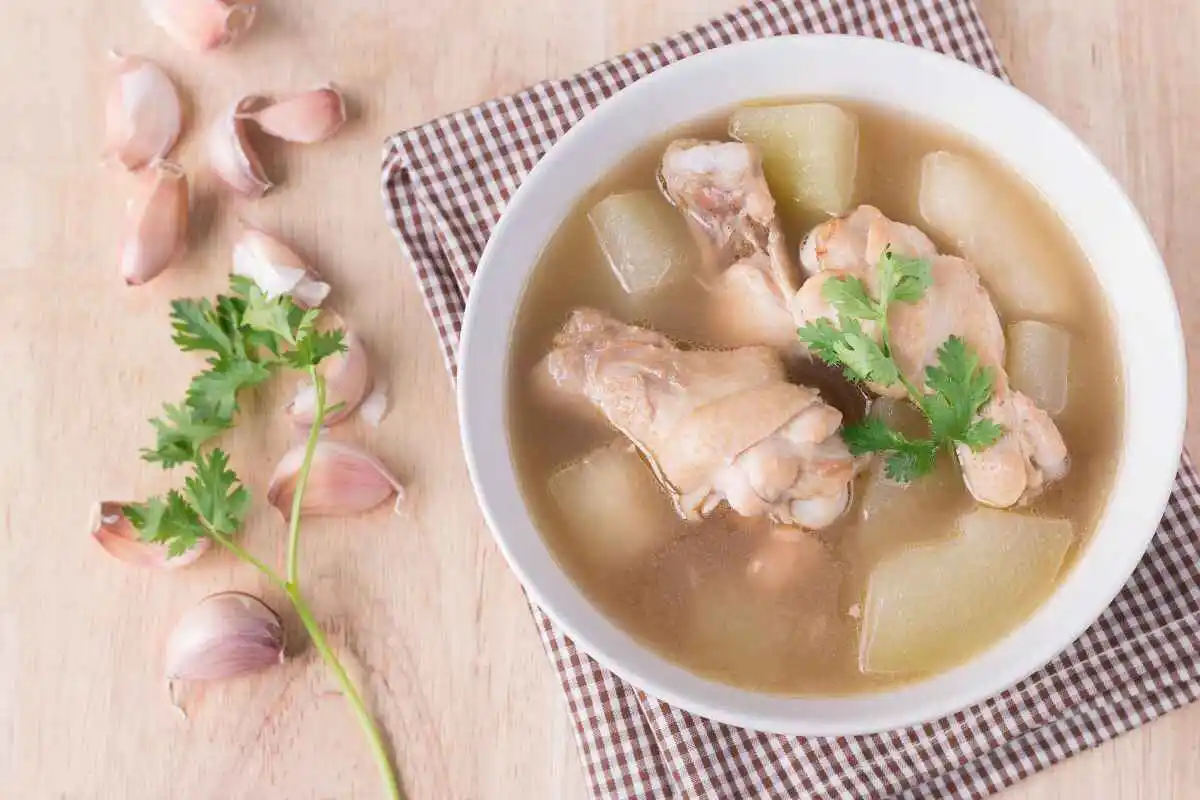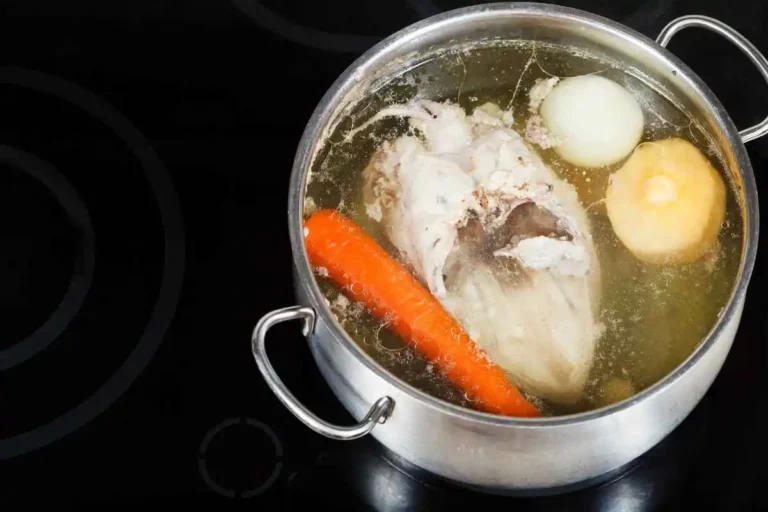Introduction
Hey there, kitchen champs! 🍳 Ready to master the art of boiling chicken? Whether you’re a beginner or looking to perfect your technique, you’ve come to the right place. Boiling chicken is a simple yet essential skill that forms the base for countless delicious dishes. From soups and salads to sandwiches and casseroles, knowing how to boil chicken perfectly can elevate your cooking game. Let’s dive into the wonderful world of boiling chicken and discover how to make it tender, flavorful, and just right every time!
Table of Contents
“Boiling chicken is the foundation of many great recipes. Master it, and you’ve unlocked endless culinary possibilities!”
Why Boil Chicken?
So, why should you learn how to boil chicken? 🤔 Well, boiling is one of the healthiest cooking methods out there. It requires no added fats, making your meals lighter and healthier. Plus, boiled chicken is incredibly versatile. You can shred it for tacos, slice it for salads, or dice it for hearty stews. It’s also a great way to infuse flavors into the chicken, making every bite delicious.
Another great reason to boil chicken is its simplicity. You don’t need fancy equipment or complicated techniques. Just a pot, some water, and a few ingredients to season your chicken, and you’re good to go. Whether you’re meal prepping for the week or cooking a quick dinner, boiled chicken is a reliable and tasty option.
Choosing the Right Chicken Cut
Before we start boiling, let’s talk about choosing the right chicken cut. 🐔 The type of chicken you use can greatly affect the outcome of your dish. Here are some common options:
Breasts vs. Thighs
Chicken breasts and thighs are the most popular cuts for boiling, and each has its own benefits.
- Chicken Breasts: These are lean and high in protein, making them a favorite for those watching their fat intake. However, they can dry out if overcooked.
- Chicken Thighs: Thighs are richer in flavor and have a bit more fat, which helps keep them moist during cooking. They’re perfect for dishes where you want a juicy texture.
Pro Tip: If you’re unsure, go for bone-in thighs. They tend to stay juicier and more flavorful compared to boneless breasts.
Bone-In vs. Boneless
Another important choice is whether to use bone-in or boneless chicken.
- Bone-In Chicken: Cooking chicken with the bone helps retain moisture and adds extra flavor to the meat. It’s ideal for dishes where you want a rich taste.
- Boneless Chicken: Boneless chicken is quicker to cook and easier to handle, especially for dishes like salads or sandwiches where you need the meat to shred easily.
Choose bone-in for maximum flavor and moisture, or boneless for convenience and versatility. It all depends on your recipe and personal preference!
“Choosing the right cut of chicken can make all the difference in your cooking. Pick wisely for the best results!”
Preparing the Chicken
Now that you’ve selected your chicken, let’s get it ready for boiling. 🧼 Proper preparation ensures that your chicken cooks evenly and absorbs all those wonderful flavors.
Cleaning and Trimming
First things first: clean your chicken. Rinse the chicken pieces under cold water and pat them dry with paper towels. 🧼 Removing excess moisture helps the chicken cook more evenly and prevents the water from bubbling over during boiling.
Next, trim any excess fat or skin. While some fat is good for flavor, too much can make your dish greasy. Use a sharp knife to carefully remove any unwanted parts.
Seasoning Options
Seasoning your chicken before boiling is key to enhancing its flavor. 🧂 Here are some simple seasoning ideas:
- Basic Seasoning: Salt and pepper are essentials. They bring out the natural flavors of the chicken.
- Herbs: Add herbs like thyme, rosemary, or bay leaves for an aromatic touch.
- Spices: Garlic powder, onion powder, and paprika can add depth and warmth to your chicken.
- Vegetables: Toss in some onions, carrots, and celery to infuse more flavor into the broth.
Pro Tip: Don’t be afraid to experiment with different herbs and spices to find your favorite flavor combination! 🌿
“Seasoning is the secret to making boiled chicken flavorful and delicious. Don’t skip this step!”
Boiling Techniques
Alright, let’s get to the boiling part. 🔥 There are a couple of techniques you can use to boil chicken, each with its own benefits.
Basic Boiling Method
The basic boiling method is straightforward and perfect for most recipes. Here’s how to do it:
- Fill the Pot: Place your chicken pieces in a large pot and cover them with cold water. Make sure there’s enough water to fully submerge the chicken.
- Add Seasonings: Throw in your chosen herbs, spices, and vegetables for added flavor.
- Bring to a Boil: Heat the pot over medium-high heat until it starts to boil.
- Simmer: Once boiling, reduce the heat to low and let it simmer. Cover the pot partially to keep the flavors in.
- Cook Until Done: Cook the chicken until it reaches an internal temperature of 165°F (74°C). This usually takes about 15-20 minutes for boneless breasts and 30-40 minutes for bone-in thighs.
Pro Tip: Skim off any foam that rises to the top during the initial boil to keep your broth clear and clean.
Using a Pressure Cooker
If you’re short on time, a pressure cooker can be a game-changer! ⏱️ It cooks chicken much faster while keeping it juicy and tender.
- Prepare the Cooker: Add the chicken, seasonings, and enough water to cover the chicken in your pressure cooker.
- Seal and Cook: Seal the lid and set the cooker to high pressure. Cook for about 10 minutes for boneless pieces and 15 minutes for bone-in pieces.
- Release Pressure: Once done, use the natural release method for about 10 minutes before releasing any remaining pressure manually.
Using a pressure cooker not only saves time but also intensifies the flavors, making your boiled chicken even more delicious. 🌟
“A pressure cooker is your best friend when you need perfectly boiled chicken in a fraction of the time!”

Time and Temperature
Getting the timing and temperature right is crucial for perfect boiled chicken. Let’s break it down. ⏲️
How Long to Boil Chicken
The boiling time depends on the type and size of the chicken pieces you’re using:
- Boneless Chicken Breasts: 15-20 minutes
- Bone-In Chicken Breasts: 30-40 minutes
- Boneless Thighs: 20-25 minutes
- Bone-In Thighs: 35-45 minutes
Pro Tip: Always check the internal temperature with a meat thermometer to ensure it reaches 165°F (74°C) for safety.
Optimal Boiling Temperature
Boiling chicken at the right temperature ensures it cooks evenly without becoming tough:
- Start with Cold Water: Begin boiling your chicken in cold water to allow it to cook evenly from the inside out.
- Maintain a Simmer: Once boiling, reduce the heat to maintain a gentle simmer. A rolling boil can make the chicken tough and overcooked.
Keeping the temperature steady helps achieve tender, juicy chicken every time. 🌡️
“Maintaining the right temperature is key to juicy and tender boiled chicken.”
Adding Vegetables and Herbs
Enhance the flavor of your boiled chicken by adding vegetables and herbs. 🥕🌿 These additions not only infuse the chicken with delicious flavors but also create a tasty broth you can use in other recipes.
Flavor Enhancers
To take your boiled chicken to the next level, consider these flavor enhancers:
- Garlic: Adds a savory depth.
- Onions: Sweetens the broth and enhances flavor.
- Bay Leaves: Introduces a subtle earthy aroma.
- Black Peppercorns: Adds a hint of spice.
Pro Tip: Adding a splash of lemon juice or a few sprigs of fresh herbs like thyme or rosemary can brighten the flavors and add complexity to your broth.
Common Additions
Here are some common vegetables and herbs you can add to your boiling pot:
- Carrots: Sweet and crunchy, they add color and nutrition.
- Celery: Provides a mild, savory flavor.
- Parsley: Freshens up the dish with its bright flavor.
- Thyme: Adds an earthy and slightly minty taste.
Feel free to mix and match based on your preference. The more, the merrier when it comes to enhancing your chicken’s flavor! 🥄
“Adding vegetables and herbs not only boosts flavor but also makes your broth versatile for future recipes.”
Now that you know how to choose and prepare your chicken, let’s tackle some common problems you might encounter when boiling chicken and how to solve them. 🛠️
Common Problems and Solutions About Boil Chicken
Even the most experienced bakers can run into a few bumps when boiling chicken. 😅 Don’t worry! Here are some common issues you might face and how to fix them:
Preventing Cracked Chicken
Cracks in your boiled chicken can be disappointing, but with these simple tips, you can keep your chicken smooth and crack-free! 🛡️
- Use a Water Bath: Boiling your chicken in a water bath helps regulate the temperature, preventing sudden changes that cause cracks.
- Avoid Overmixing: When mixing your filling or handling the chicken, be gentle. Overmixing can incorporate too much air, leading to cracks as the chicken cooks and cools.
- Proper Cooling: Allow your chicken to cool gradually by leaving it in the pot or oven with the door slightly open. Rapid cooling can cause the chicken to contract and crack.
- Don’t Overbake: Remove the chicken from the heat when it still has a slight jiggle. It will continue to set as it cools, reducing the risk of cracks.
“A well-baked cheesecake is a testament to patience and precision in the kitchen.”
Achieving Perfect Texture
The texture of your boiled chicken is crucial for that melt-in-your-mouth experience. 🥄 Here’s how to ensure it’s perfectly creamy and tender:
- Room Temperature Ingredients: Ensure all your ingredients, especially the chicken, are at room temperature before cooking. This helps the chicken cook evenly without becoming tough.
- Mix Gently: Whether you’re mixing the chicken with other ingredients or handling it, do so gently to maintain a light and creamy texture.
- Proper Cooking Time: Boil the chicken just until it reaches an internal temperature of 165°F (74°C). Overcooking can make the chicken dry and crumbly.
🌟 Tip: Use a meat thermometer to check the internal temperature for the best results.
Balancing Flavors
Achieving the right balance between sweet and savory flavors can make your boiled chicken truly exceptional. 🍓 Here’s how to get it just right:
- Quality Ingredients: Use fresh, high-quality chicken and fresh herbs to enhance the natural flavors.
- Seasoning Adjustments: Taste your broth before cooking and adjust the seasoning as needed. If it’s too bland, add more salt or spices.
- Acidity: A splash of lemon juice or a few sprigs of fresh herbs can brighten up the flavors and add a refreshing zing.
“A well-balanced cheesecake is a harmonious blend of sweet and tart that dances on your taste buds.”
Storing Boiled Chicken
Proper storage is key to keeping your boiled chicken fresh and tasty. 🧊 Here’s how to store your boiled chicken effectively:
Refrigeration Tips
- Cool Completely: Let the boiled chicken cool to room temperature before refrigerating to prevent condensation and sogginess.
- Use Airtight Containers: Store the chicken in airtight containers to keep it fresh and prevent it from absorbing other odors in the fridge.
- Shelf Life: Boiled chicken can be stored in the refrigerator for up to 5 days. Make sure to label the container with the date for easy tracking.
Freezing Boiled Chicken
- Proper Packaging: Wrap the boiled chicken tightly in plastic wrap and then place it in a freezer-safe bag or container to prevent freezer burn.
- Freeze Quickly: Place the wrapped chicken in the freezer as soon as it’s cooled to maintain its quality.
- Storage Duration: Boiled chicken can be frozen for up to 2 months. Beyond that, the quality may start to decline.
🍗 Pro Tip: Slice or shred the chicken before freezing for easier use in future recipes.
“Storing your cheesecake properly preserves its creamy texture and delightful flavor for every bite.”
Using Boiled Chicken in Recipes
Boiled chicken is incredibly versatile and can be used in a variety of delicious recipes. 🍽️ Here are some ideas to get you started:
Salads and Sandwiches
Boiled chicken is perfect for adding protein to your salads and sandwiches. 🥗🥪
- Chicken Salad: Combine shredded boiled chicken with mayonnaise, celery, grapes, and nuts for a classic chicken salad.
- Grilled Chicken Sandwich: Layer sliced boiled chicken with lettuce, tomato, and your favorite condiments on toasted bread.
- Caesar Salad: Add grilled or shredded boiled chicken to a Caesar salad for a hearty meal.
Soups and Stews
Boiled chicken is a great addition to soups and stews, adding depth and richness to the broth. 🍲
- Chicken Noodle Soup: Use boiled chicken to create a comforting chicken noodle soup with vegetables and pasta.
- Chicken and Rice Stew: Combine boiled chicken with rice, vegetables, and broth for a hearty stew.
- Chicken Tortilla Soup: Add boiled chicken to a spicy tomato-based soup with corn, beans, and tortillas.
🥄 Pro Tip: Reserve some of the boiling liquid to use as a flavorful base for your soups and stews.
“Using boiled chicken in your recipes opens up a world of delicious possibilities.”
Nutritional Information
Understanding the nutritional content of boiled chicken can help you make healthier choices and enjoy your meals guilt-free. 🥗 Here’s a simple breakdown of the key nutrients:
Calorie Breakdown
| Nutrient | Amount per Serving |
|---|---|
| Calories | 165 kcal |
| Carbohydrates | 0g |
| Protein | 31g |
| Fat | 3.6g |
| Fiber | 0g |
| Sugar | 0g |
| Sodium | 74mg |
Health Benefits
- High in Protein: Boiled chicken is an excellent source of lean protein, essential for muscle growth and repair.
- Low in Fat: It’s a low-fat option, making it ideal for those looking to maintain a healthy weight.
- Rich in Vitamins: Boiled chicken provides essential vitamins like B6 and B12, which support metabolism and brain health.
- Mineral-Rich: It contains important minerals such as phosphorus and selenium, which are vital for bone health and immune function.
🍗 Pro Tip: Pair boiled chicken with a variety of vegetables and whole grains to create a balanced and nutritious meal.
“Indulging in a slice of strawberry cheesecake is a delightful way to enjoy both flavor and a touch of nutrition.”
FAQs: Your Questions Answered About Boil Chicken
Can I use turkey instead of chicken for boiling?
Absolutely! 🦃 You can use turkey in place of chicken for boiling. The process is very similar, and the results are just as delicious. However, keep in mind that turkey may take a bit longer to cook due to its larger size and denser texture. Make sure to adjust the boiling time accordingly and check that the internal temperature reaches 165°F (74°C) for safety.
- Tip: Use turkey thighs or drumsticks for a richer flavor, similar to chicken thighs.
- Flavor Adjustment: Consider adding additional herbs and spices to complement the stronger flavor of turkey.
“Using turkey instead of chicken can add a unique twist to your boiled recipes, perfect for holiday meals or special occasions.”
Whether you choose chicken or turkey, the key is to follow proper boiling techniques to ensure tender and flavorful meat every time. 🥄
Conclusion About Boil Chicken
Why This How to Boil Chicken Recipe Stands Out
This how to boil chicken guide is your go-to resource for perfectly cooked, juicy chicken every time. 🐔 Here’s why it stands out:
- Rich and Creamy: Using high-quality ingredients ensures a smooth and flavorful result.
- Versatile: Whether you prefer boneless, bone-in, breasts, or thighs, this guide covers it all.
- Easy to Follow: Step-by-step instructions make it simple for bakers of all skill levels.
- Beautiful Presentation: Proper seasoning and cooking techniques result in a visually appealing dish.
- Balanced Flavors: The perfect mix of herbs and spices creates a harmonious taste experience.
Whether you’re preparing a family dinner, a special celebration, or just a healthy meal, this boiled chicken recipe is perfect for any occasion. 🏆🍗
Encouraging Readers to Try and Share
Now that you have the ultimate how to boil chicken recipe, it’s time to get cooking! 🔥 Whether you’re planning a hearty soup, a fresh salad, or a delicious sandwich, this boiled chicken will impress everyone at your table.
Don’t keep this deliciousness to yourself—share the recipe with friends and family. Encourage them to try it out and add their own twists. After all, good food is best enjoyed together! 🍽️
If you try this recipe, we’d love to hear about your experience. Share your creations on social media using the hashtag #BoiledChickenMagic and join a community of fellow cooking enthusiasts who are perfecting their boiled chicken techniques. 📸
“Cooking brings people together. Share your boiled chicken creations and spread the joy!”
So, what are you waiting for? Gather your ingredients, follow the steps, and enjoy perfectly boiled chicken that’s tender, juicy, and full of flavor. Your taste buds will thank you! 😋
Happy cooking, and bon appétit! 🎉

